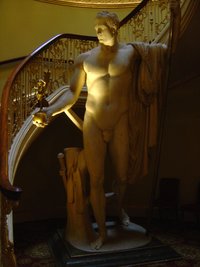Apsley House
|
|
Apsley_House_in_1829_by_TH_Shepherd.JPG
The_Waterloo_Gallery_at_Apsley_House_by_Joseph_Nash,_1852.jpg
Apsley_House_1.JPG
Apsley_house_on_an_1869_Ordnance_Survey_Map.JPG

Apsley House, also known as Number 1, London, was the London residence of the First Duke of Wellington and stands alone at Hyde Park Corner, on the south-east corner of Hyde Park, facing south towards the busy traffic circulation system.
It was originally built in red brick by Robert Adam between 1771 and 1778 for lord chancellor Baron Apsley who later became the 2nd Earl Bathurst, and who and gave the house its name.
The house was given the popular nickname of Number 1, London, since it was the first house passed by visitors who travelled from the countryside after the toll gates at Knightsbridge. It was originally part of a contiguous line of great houses on Piccadilly and its official address remains 149 Piccadilly, W1J 7NT.
In 1807 the house was purchased by the Marquess Wellesley, the elder brother of Arthur Wellesley, but in 1817 financial difficulties forced him to sell it to his famous brother, then the Duke of Wellington, who needed a London base from which to pursue his new career in politics.
Wellington employed the architect Benjamin Dean Wyatt to carry out renovations between 1818 and 1819. He extended the house by adding two bays westward to the original five; built the Waterloo Gallery for the Duke's paintings, and faced the red brick with the more fashionable Bath stone. He also introduced his own version of French style to the interior and installed the nude statue of Napoleon by the Italian Neo-classical sculptor Antonio Canova in the stairwell.
During World War II, it was rumoured that King George and Queen Elizabeth heard that the treasures of the house hadn't been evacuated. The story goes that they both arrived in a van and quickly had the objects moved to Frogmore for safekeeping.(1)
The 7th Duke gave the house to the nation in 1947, but the family retains an apartment on the second floor (U.S. third floor). The house is now owned by English Heritage and is open as a museum and art gallery. It is sometimes referred to as the Wellington Museum. It is perhaps the only preserved example of an English aristocratic town house from its period. The practise has been to maintain the rooms as far as possible in the original style and decor. It contains the First Duke's collection of paintings, porcelain, silver, sculpture and furniture. Paintings by artists including Goya, Velasquez, Rubens and Brueghel.
References
1:Blaikie, Thomas (2002) You look awfully like the Queen, Wit and Wisdom from the House of Windsor. Harper Collins. ISBN 0007148747
External links
- Page on English Heritage's website (http://www.english-heritage.org.uk/default.asp?wci=mainframe&URL1=default.asp%3FWCI%3DNode%26WCE%3D811%26document_from%3Dhttp%253A//www.english-heritage.org.uk/filestore/visitsevents/asp/visits/Details.asp%253FProperty_Id%253D415)
- Aerial photo and map (http://www.multimap.com/map/photo.cgi?client=public&X=528250&Y=180000&width=500&height=310&gride=&gridn=&srec=0&coordsys=gb&db=pc&pc=&zm=0&scale=5000&out.x=2&out.y=6) - Apsley House is marked "Wellington Museum.
